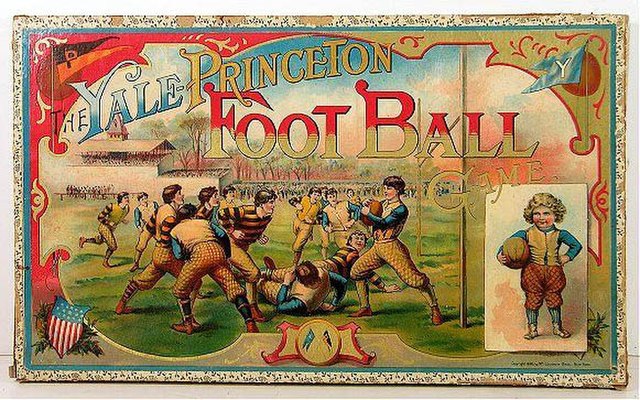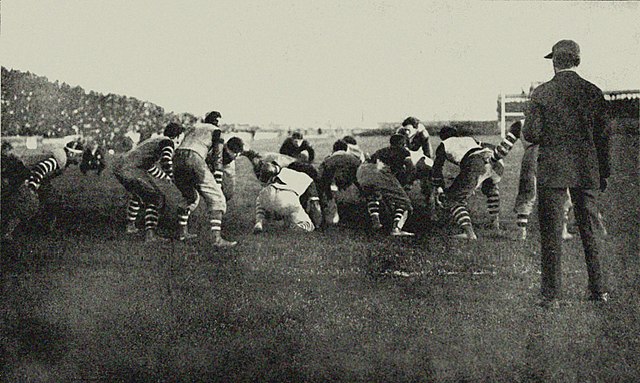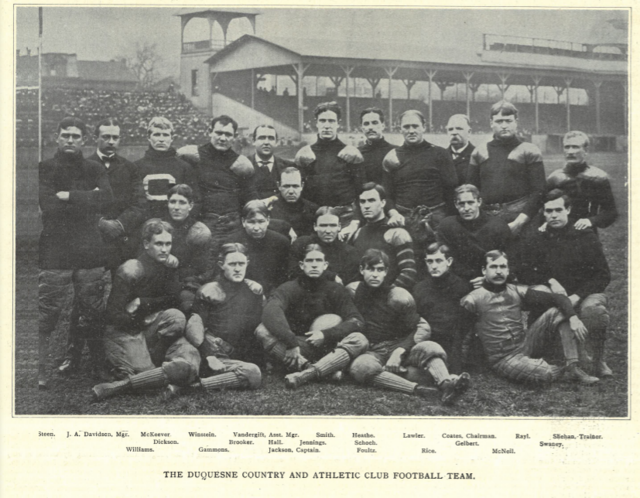A quick look at football in the last six seasons of the 19th century. Football History Rewind where we take a year-by-year approach of the history of American Football.
Football 1895 thru 1900
1895 thru 1899 Champs
We haven't talked too much about the crowned National Champions of the latter half of the decade of the 1890s, so here is our catch up on the teams that vied for the title each year.
1895

Courtesy Wikimedia Commons, An illustration depicting of an 1895 Ivy League game. "The Yale-Princeton Foot Ball Game".
The previous part of the decad saw Yale, Princeton and even Harvard battling for the nation's top spot on the gridiron hierarchy. It all changed in 1895 as the University of Pennsylvania's football eleven rose to new heights. The Penn Quakers under Head Coach George Woodruff finished with an unmatched 14–0 record and was retroactively named as the national champion by the Houlgate System, National Championship Foundation, Helms Athletic Foundation, and Billingsley Report, and as a co-national champion by Parke H. Davis. The Quakers outscored their opposition by the tune of 480 points for and only 24 against. Their closest game happened in th second to last contest of the season against Harvard when Penn escaped with a 17-14 vicory over the Crimson. Parke H. Davis was the sole selector of Yale as the co-champion with Penn. The Bulldogs had an unblemished record of 13-0-2 with the ties happening aginst the Boston Athletic Club and Brown University.
Caspar Whitney and Walter Camp once against selected an All-American team and 10 of the eleven played for Harvard, Princeton or Yale. The lone exception was Cornell's fine quarterback Clint Wykoff.
1896

Lafayette on defense in its 6-4 upset victory over Pennsylvania in college football on October 24, 1896 at Franklin Field in Philadelphia, Pennsylvania. From the book "Football - The American Intercollegiate Game", written by Parke H. Davis in 1911.
Another new-comer to the top spot in Collegiate football occurred in 1896. In week two of the season the Princeton Tigers tied Lafayette and it ended up being an omen for the season's finish as these two teams shared the National Championship according to the National Championship Foundation and Parke Davis. Lafayette not only tied the Tigers but also had 6-4 upset victory over the University of Pennsylvania on October 24, 1896 at Franklin Field in Philadelphia. Houlgate, Billingsly and the Helms Athletic Foundation found favor in calling out Princeton as the sole winner. I think Davis and the NCF got it right on this as the teams tied when faced against each othre and crushed all other opponents they played to end up with identical 11-0-1 records.
In Professional football the Pro Football Hall of Fame tells us that the first team of all paid players took the field for the Allegheny Athletic Association near Pittsburgh for a two game abbreviated season. The Club decided not to field a team in 1895 after an investigation by the Amateur Athletic Union was launched after accusations swirled that AAA was paying players. Fearing that having a pro status would discourage any opponents from playing them they sat out a year and then dipped their toes in the pro water in 1896 after they knew that the AAU was suspending them from amateur competition. Knowing full well what was coming the AAA emptied the treasury of the club to buy player contracts to get a couple of games in. On consecutive days AAA defeated the Pittsburgh Athletic Club and the Duquesne Country and Athletic Club, both by means of shutouts. Then, these two games, the pro football turmoil and AAU suspension had upset the club so much that the sport was dropped altogether by the membership.
1897
Once again co-champions were selected years later by experts choosing Yale and Penn to the top spot. Yale withits 9-0-2 mark was picked by only one entity, Mr. Parke H. Davis as National Champion. Their ties were against Army and Harvard. All selectors took the more obvious choice, the Penn Quakers were a perfect 15-0 for their record.
On the pro circuit the Latrobe Athletic Association fielded an all professional team and unlike AAA the year prior, were the first pro team to complete a full season.
1898
The decision was not clear-cut and unanimous for the next season either. Co-champions Princeton and Harvard had to share the honor. Harvard had a perfect 11-0-0 record, defeating their nemesis Yale 17-0 in the season finale and not facing Princeton. The Tigers sported an 11-0-1 record with their tie coming against Army in a 5-all stalemate late in the season. Drexel also was perfect at 7-0 along with many teams that were 2-0 and 3-0 across the country.
December 3, 1898 the Latrobe Athletic Association's manager Dave Berry recruited some of the best players from teams local to the Pittsburgh area in order to play a team of some of the nation's best players assembled by the Duquense Country and Athletic Club. This was the first recorded playing of two professional All-Star teams in Pro football. Duquense won the contest 16-0 at Exposition Park in Allegheny City, which is now the North side of the City of Pittsburgh.

Photo is courtesy of Wikipedia Commons of the 1899 by an unknown photographer of Duquense Country A.C. football team, posed at Exposition Park, Pittsburgh, PA November 25, 1899
1899
A repeat in the next year. As the Official NCAA Division I Football Records Book recorded Harvard and Princeton as having been selected sharing the national championship title. Sewanee had a great season of note going undefeated with only 13 players on their roster and outscoring opponents 322-10 with a 12-0 record in the Southern Intercollegiate Athletic Association. The University of Chicago under Amos Alonzo Stagg also had a strong showing that year posting a 16-0-2 record. The Maroons ties were against tough Iowa and Penn teams but four of the wins were against local high school competition.
Also in Chicago that year, Chris O'Brien formed a neighborhood football team called the Morgan Athletic Club that would eventually morph into the the Cardinals Franchise which still plays as the Arizona Cardinals in the NFL.
1900
John Heisman coached Clemson to a 6-0 record and was probably the top team in the South in college football, but Yale doubled the amount of the Tigers victories in a little bit better and established region at the time in college football. Iowa and Indiana joined the Western Conference which was the precursor to the modern Big Ten Conference, but at the time these two additions gave the Western Conference the nickname of the Big Nine, and eventually led the name change.
At the Pro level, William C. Temple became the first individual to own a professional football club when he took over all payments of the Duquense Country and Athletic Club team near Pittsburgh.
Photo Credits
The photograph in the banner above is courtesy of the Wikimedia Commons collection of public Domain pictures. Taken by an unknown photographer of the Duquense Country A.C. football team, posed at Exposition Park, Pittsburgh, PA November 25, 1899





